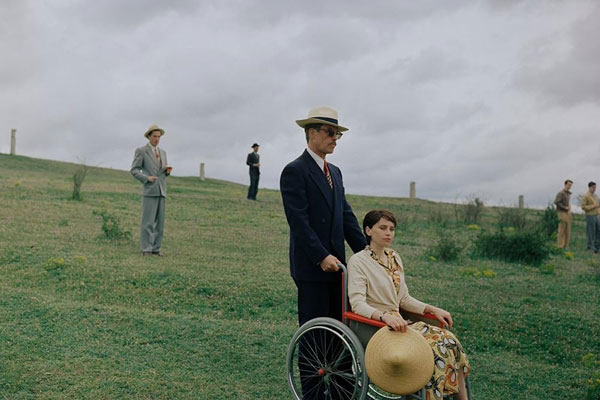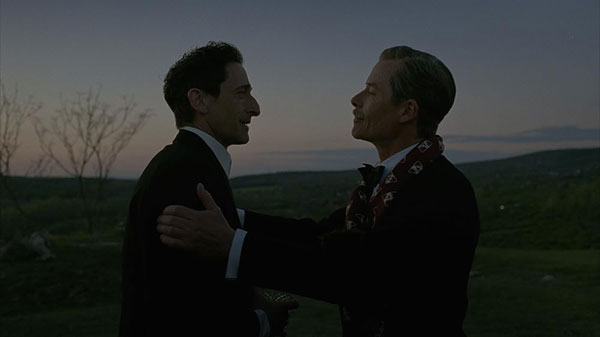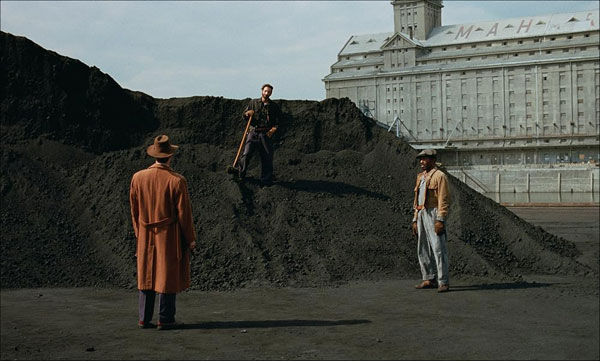|
When I think of The Brutalist, I think of cliffs.
Specifically, I think
of the cliffs within
the marble quarries of
Carrara, Italy, in
operation for more than
2,000 years. Those
cliffs stand jagged and
grayish-white, dwarfing
and mocking those who
carve them into blocks
and haul them
away. They
outlasted the emperors
who built the Forum;
they will outlast us.
The cliffs of Carrara appear in the second half of The Brutalist, Brady
Corbet's epic yet
claustrophobic
film. That
sequence serves as one
of the operant
metaphors in the film,
and ends with an act of
violence that makes the
metaphor all the
more…well, brutal.
The screenplay by
Corbet and Mona
Fastvold opens with an
epigraph from Goethe:
"None are more
hopelessly enslaved
than those who falsely
believe themselves
free." Corbet
quickly follows with The Brutalist's other
operant metaphor:
Laszlo Toth (Adrien
Brody)—a
Hungarian architect,
Holocaust survivor, and
refugee--arrives in New
York in 1947. We
see Laszlo winding his
way through the Stygian
bowels of a ship, until
at last he cries out
for joy: the Statue of
Liberty!
We see the statue the way Laszlo first sees it. It is upside down.
The Brutalist is
essentially about
Laszlo's struggle to
gain a professional
foothold in his adopted
country and his
eventual
disillusionment.
"They don't want us
here!" he screams at
his wife Erszebet
(Felicity Jones) toward
the end, and by then it
is hard to see how he
could have reached any
other
conclusion.

Corbet and Fastvold set the action of The Brutalist between 1947
and 1960, with a brief coda in 1980. They strive to make the film
seem like an artifact of its era: it is shot in VistaVision, a
widescreen photographic technology used mainly in the 1950s.
The ultra-long (215 minutes) film is divided neatly by a 15-minute
intermission, during which a picture of Laszlo and Erszebet's
wedding, in Budapest in 1936, is projected on the screen. The
intermission divides the film into two sections: the first is a
relatively traditional story of an underdog overcoming obstacles
to achieve success, and the second is a far more shocking story of
disillusionment and degradation. The photograph of the happy
wedding celebrants provides a deeper irony. Most of the people
in that picture were murdered by the Nazis. Laszlo has been cut
off from his own past, and the future is something he can neither
anticipate nor control.
There are many themes in The Brutalist: the aftereffects of the
Holocaust; hostility toward immigrants in general and Jews in
particular; the constant war between art and commerce; and the
lonely obsessiveness of the artist. Alexandra Schwartz's New
Yorker profile of Corbet demonstrates that he understands the
last two themes very well. "It was very important for me to get
outside of the U.S. system," Corbet told Schwartz, explaining why
a film set mostly in Pennsylvania was filmed in Hungary. "It's not
a director's medium, it's an executive's medium." He also
described his idea of the director's task: "I think it requires a truly
obsessive level of devotion that is borderline unhealthy. It's like
an affliction."
Laszlo Toth is afflicted in this way, and in many others. We come
to see that his unadorned concrete buildings, typical of the
Brutalist style, are informed by his experiences at Buchenwald.
At the beginning, he comes alone to America; Erszebet and their
niece Zsofia (Raffey Cassidy) are still in Hungary, unable to obtain
visas. He goes to stay in Philadelphia with his cousin Attila
(Alessandro Nivola), a furniture store owner, and his
unsympathetic Catholic wife Audrey (Emma Laird). Their
hospitality is parsimonious at best, and eventually they kick him
out. Part of the rupture between the cousins can best be
described as a variation on the story of Joseph and Potiphar's wife
. The other reason is the ire of Harrison Lee Van Buren (Guy
Pearce), a tycoon and frequent customer of Attila's, who is
enraged at Laszlo's redesign of his library, as commissioned by
Van Buren's son Harry (Joe Alwyn) as a birthday surprise.
Laszlo is living in a homeless shelter and shoveling coal when Van
Buren comes calling. He's read up on Laszlo and his pre-World
War II projects; he is all apologies, he pays Laszlo the fee he
withheld before, and he invites Laszlo to his estate to meet his
friends and discuss a project for a multipurpose community
center on his property. He flatters Laszlo, telling him their
conversations are "intellectually stimulating." He also offers to
have his lawyer cut through the red tape to bring Erszebet and
Zsofia to America.

This is where the intermission leaves us. The first event in the
second half is Erszebet and Zsofia arriving by train in
Philadelphia. Erszebet, weakened by malnutrition and
osteoporosis, is in a wheelchair, and Zsofia is mute. The second
event, which I will not reveal, takes place at the welcoming party
for Erszebet and Zsofia. It is a small gesture, but it illustrates Van
Buren's true attitude toward Laszlo, which is no higher than it
first appeared when he screamed at him to leave his house. It is a
classic example of Maya Angelou's dictum: "When someone
shows you who they are, believe them the first time."
From that point, the relationship between Laszlo and Van Buren
goes downhill, as the latter insists on letting bean counters
cheapen Laszlo's towering conceptions. Van Buren's interference
goes far beyond thinking that he has the right to modify the
project because he's paying for it. Van Buren revels in the
knowledge that Laszlo needs his money, and he believes that not
only makes him Laszlo's superior, but his owner. Each time he
says his conversations with Laszlo are "intellectually stimulating,"
he makes it more evident which intellect he thinks is the greater
of the two. (It is telling that, when he decides he must downscale
the plan for the community center, the first thing he cuts is its
library.) Pierce's Van Buren reminds me of Steve Carell's John
DuPont in Foxcatcher; both are men who believe that money
confers genius, as well as privilege amounting to divine right. If
you can think of current real-life parallels to Van Buren and
DuPont, you are doing your job as a member of the audience.
This is not to say that Laszlo is a saint. The basic outlines of his
story are taken from those of actual Brutalist architects, especially
Marcel Breuer, but Breuer and other European Brutalists came to
America before World War II. In any case, Laszlo combines an
adamant faith in his own genius with the PTSD he derived from
the camps. Adrien Brody captures brilliantly the contradictions of
this arrogant, vulnerable, deeply sympathetic man. Laszlo is
addicted to heroin and pornography (he celebrates his first night
in America with a hooker); he forgoes his fee to pay for the
building materials vetoed by the bean counters; he dismisses an
old friend, cruelly and permanently, in a momentary fit of pique.
Through good and bad, we are always on his side. His most heart
-melting moment comes when Van Buren, early in his association
with Laszlo, shows him architectural magazines detailing his
prewar achievements in Europe. Laszlo—after years of
imprisonment, followed by poverty in America—is pathetically
grateful for this evidence that once he was a man of distinction.
"May I have this?" he asks.
As Erszebet, Felicity Jones is fully the equal of Brody and Pierce.
We only see her in the film's second half, although she has a
strong presence in the first half through her letters to Laszlo.
Disabled and in excruciating pain (for which Laszlo,
unfortunately, has a cure), Erszebet is nevertheless the film's
moral center. She is fully with her husband when he pours his
fee, and in essence their livelihood, back into the Van Buren
project, but she will not countenance his acts of cruelty or fits of
rage. A journalist in Hungary, she pursues any writing job she
can get in America, the strength of her will superseding the
weakness of her body. Toward the end, she takes an enormous
physical risk to confront Van Buren and his son Harry—who has
all of his father's egomania and sense of privilege, but none of his
intelligence—in a way that Laszlo never could.

Throughout The Brutalist, Corbet receives invaluable help from
cinematographer Lol Crawley and production designer Judy
Becker. Together, Crawley and Becker create unforgettable scenes
that emphasize both the arduousness of Laszlo's life and the
monumentality of his architecture. One scene—in which the
setting sun shines through a cross-shaped window in the chapel of
Laszlo's nearly completed community center, projecting an image
of the cross on the opposite wall—illustrates perfectly Laszlo's
imaginative brilliance as an architect.
Of movies in this century, The Brutalist reminds me most of Paul
Thomas Anderson's There Will Be Blood and The Master, in
which forbidding, larger-than-life protagonists engage in open
warfare with their societies and each other. It is hard to imagine
viewers cherishing The Brutalist; it is equally hard to imagine
them not being impressed or even awed by it. At the end, one of
the characters delivers a speech that upends a familiar maxim. It
is up to viewers whether they agree with it, but it is evident that
Laszlo Toth does.
|